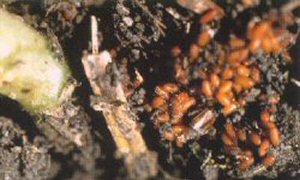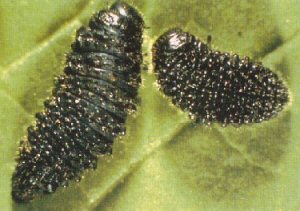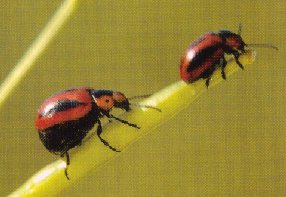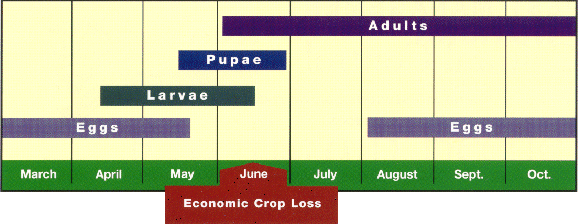Red Turnip Beetle
In May and June, infestations of both larvae and adults originate in stubble fields of canola, rapeseed, and mustard or in other fields containing heavy stands of weeds of the mustard family (Cruciferae), which have not been controlled by cultivation or treated with herbicides during the fall or early spring.

Red turnip beetle egg cluster

Larval stage of red turnip beetle

Adult red turnip beetle

Adult beetles feeding
Introduction
Red turnip beetles are an occasional pest of canola, rapeseed and mustard in the northern Great Plains of North America. It is native to North America and relatively abundant throughout the Aspen Parkland Region of the Canadian Prairies and the Peace River District of Alberta and British Columbia. Although present in Washington, Idaho, Montana, Wyoming, Colorado, North Dakota, Minnesota, and Wisconsin, it rarely damages cruciferous crops. The use of direct seed, "zero till" and "chemical summerfallow" practices may contribute to this insect becoming an important crop pest.
Damage
Crop injury in canola, rapeseed, or mustard fields usually occurs along field margins when beetles move in after cruciferous plants in adjacent fields are either consumed or controlled. Adult beetles normally walk to the new food source. Invading beetles are usually concentrated in a moving front only a few yards wide.
Occasionally, crop damage may occur in patches throughout the crop when volunteer canola, rapeseed, mustard or weeds belonging to the mustard family were abundant the previous year and the canola, rapeseed or mustard is direct seeded with conservation tillage equipment.
The larvae and adults feed on the cotyledons, true leaves, petioles, and stems of seedlings. Depending on the size of the seedlings and on beetle abundance, damage will vary from the loss of small portions of the cotyledons and true leaves to complete defoliation and death of plants.
Small seedlings are more susceptible to damage than larger seedlings. When red turnip beetle populations are low, only plants at the edges of the fields are at risk. But when adult beetles are numerous, they invade the crop, gradually moving inward from the margins, destroying the crop as they go. In the larval stage, the red turnip beetle is not a major threat to canola, mustard, or rapeseed since it normally completes development before the host crop germinates.
In August, the summer generation adults re-invade canola, rapeseed or mustard fields and feed on the flowers, pods and stems of plants until harvest. However, adult densities at this time of year normally are not high enough to cause significant damage.
Life Cycle And Identification

Eggs
Eggs are deposited from early August to late October near the plants on which the adult beetles feed. The reddish-brown, oblong-shaped eggs are laid singly or in clusters in shallow crevices in the soil, or in loose soil under soil aggregates, leaves or other debris at a depth of less than 1/4 inch (6 mm) wide. Within 2 to 3 weeks of being deposited, the eggs are mature. They remain dormant until late March to early May, hatching in spring after snow has melted but before crops are seeded.
Larvae
Upon hatching in early spring, the grub-like larvae seek out and feed on volunteer canola, rapeseed and mustard and weeds of the mustard family, especially flixweed (Descurainia sophia (L.) Webb.) and wild mustard (Sinapis arvensis L.). Feeding takes place mainly during the daytime. When disturbed, larvae drop to the soil where their coloration blends with the soil.
The larvae are smoky black on top and brownish underneath. Larval development takes three to four weeks and is usually completed by the end of May. Larvae moult three times, becoming progressively larger with each moult. At maturity, larvae are about 1/2 inch (13 mm) long. After completing development, the larvae enter the soil, form an earthen cell and pupate.
Pupae
The pupae are present in the field from mid-May to mid-June. The bright orange pupae are characterized by body appendages that are free and distinguishable. Pupae are located within earthen cells in the top inch (two to three cm) of the soil. The pupal stage lasts about two to three weeks with the adult beetles emerging from early to late June.
Adults
The adults are about 1/2 inch (seven to 10 mm) long, bright-red with black patches just behind the head and three distinct black stripes running down the back. After emerging, the beetles feed for two to three weeks, usually in the same fields in which they fed as larvae. If the food supply is consumed or destroyed, the beetles leave the field and walk to the nearest available food source.
Near the end of June, in response to high temperatures, adults re-enter the soil for a one-month rest period. Upon reappearing in late July, adults disperse rapidly into new fields.
Adult beetles feed on the flowers, seed pods, petioles, and stems of canola, rapeseed, mustard and cruciferous weeds during August and September but do not cause significant damage to the plants at this time.
Mating occurs on the host plants within a few days of emergence. Feeding, mating, and egg laying continue until late October. Each female produces about 300 to 400 eggs.
Pest Management
Cultural Control
Red turnip beetle infestations can be reduced or prevented by using good cultural practices.
Red turnip beetle infestations originate in stubble fields previously seeded to canola, rapeseed or mustard or in other fields containing heavy stands of weeds of the mustard family, which have not been cultivated in the fall or early the following spring. For this reason, avoid the practice of underseeding canola, rapeseed, or mustard with forages.
Cultivation is an extremely effective means of reducing red turnip beetle eggs, larvae, and pupae. Cultivation after harvest buries the eggs and when they hatch, the larvae are unable to burrow out of the soil. Fall cultivation may cause 75-100 per cent mortality of newly hatched larvae the following spring.
Cultivation also controls the larvae by destroying hosts plants. When the host plants die, most larvae starve to death, for they are incapable of traveling very far for food. A similar situation occurs when herbicides are applied to control volunteer canola, rapeseed, mustard, or weeds of the mustard family while the insect is still in the larval stage.
Cultivation from mid-May to mid-June will subject pupae to mechanical injury, predation, and desiccation, reducing the potential of economic injury by red turnip beetles.
Insecticides
When adult beetles invade newly-seeded canola, rapeseed and mustard fields in June, it may be necessary to use chemical insecticides to control them. The affected fields should be examined carefully, to determine the density of beetles and whether the beetles are causing economic damage. Since they usually walk into fields from the margins and are concentrated in a moving front, insecticide application can usually be confined to plants along the field margins. If the invasion occurs late in June, the adults are unlikely to cause economic damage because plants are relatively large and the beetles will soon be entering the summer resting stage in the soil.
Before applying an insecticide consult your local agricultural representative to obtain the most recent control recommendations.
This publication has been produced as a combined effort and with the funding support of the following agencies:
- Manitoba Agriculture, Food and Rural Initiatives
- Saskatchewan Agriculture and Food
- Alberta Agriculture, Food and Rural Development
- Agriculture and Agri-Food Canada

